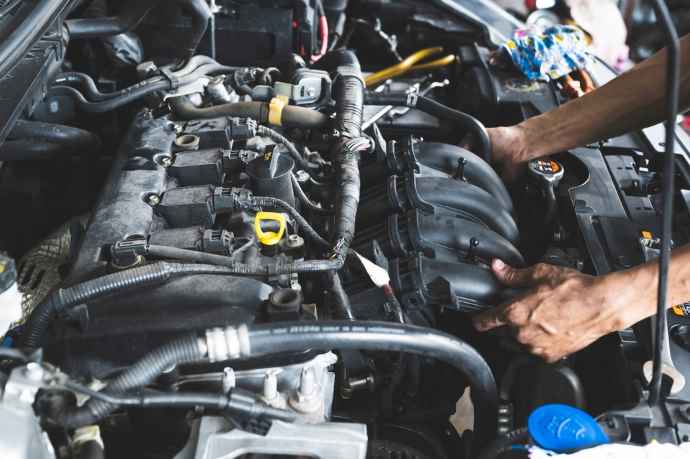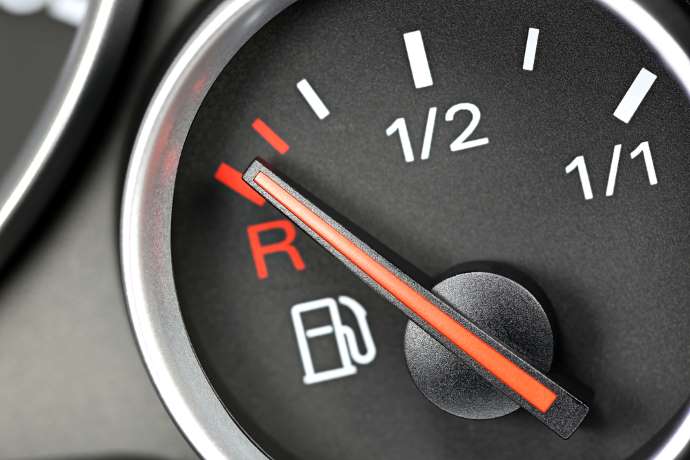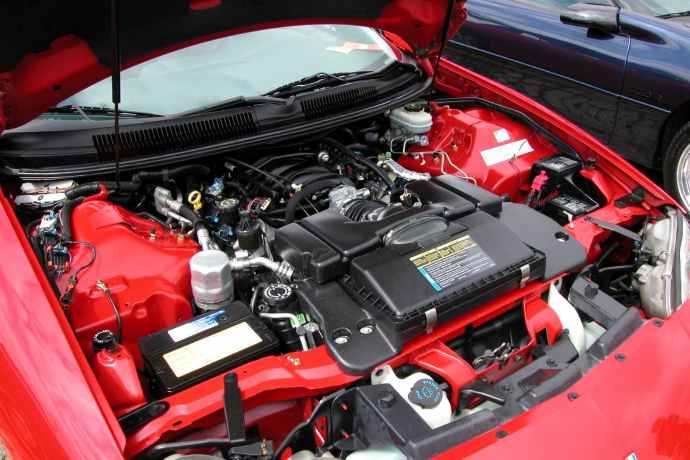The 4.8 Vortec is a V8 engine produced by General Motors.
The engine was introduced in 1999 and ended production in 2014.
The 5.3 Vortec engine replaced the 4.8 Vortec in 2013.
The 4.8 Vortec engine is popular for its power output and is used in GM vehicles.
However, the 4.8-liter engine has some common issues that must be addressed.
In this article, I have discussed the common problems with the 4.8 Vortec engine, their symptoms, and solutions.
4.8 Vortec Engine Problems [5 Common Problems, Symptoms and Solutions]
4.8 Vortec engine is prone to 5 common problems, including intake manifold-gasket air leaks, intake knock-sensor problems, high oil consumption, water pump failure, and fuel pump failure.
1. Intake Manifold and Gasket Air Leaks

One of the most common problems with the 4.8 Vortec engine is the intake manifold and gasket air leaks.
The intake manifolds regulate airflow into the engine and distribute it to all eight cylinders.
Typically, the intake manifold of the 4.8 engine is the same as the 5.3 Vortec engine and is made from plastic.
The plastic manifold is susceptible to cracking when overheated or over-torqued.
Because the intake manifold is so close to the engine, it frequently overheats and causes wear and tear.
On the other hand, the manifold gasket is poorly designed and naturally deteriorates.
As a result, air leaks occur when the manifold cracks or the gasket fails.
In this situation, the engine does not receive as much air as it requires, resulting in decreased engine power and performance.
Symptoms of Intake Manifold and Gasket Air Leaks
- Reduced engine power
- Slow acceleration
- Poor idling
- Engine starting issues
- Check engine light illuminates
Solution
To resolve intake manifold and gasket leaks, follow these 7 steps:
- Inspect and identify the source of air leaks from the intake manifold and gasket.
- After identifying the source of the leak, carefully remove the intake manifold and gasket. [Ensure the engine is cold during this process.]
- Now check the damage to the intake manifold and gasket.
- If any damage is found, replace the components.
- Before installing a new gasket, thoroughly clean the manifold and gasket surface and precisely position them.
- Reinstall the intake manifold and torque the bolts in a crisscross pattern to the manufacturer’s specifications.
- Now, start the engine and check for leaks.
The average replacement cost of an intake manifold gasket is around $550 to $620, including parts and labor costs.
Watch this video to learn how to tell your intake manifold is leaking.
2. Intake Knock Sensor Problem
The intake knock sensor is a vital vehicle component that detects engine knock or detonation.
The sensor sends the necessary information to the ECM to correct the ignition timing and prevent excessive engine knocking.
Generally, the intake knock sensor is mounted on the intake manifold or engine block.
It uses a piezoelectric crystal to detect vibrations and pressure charges caused by knocking.
The intake knock sensor on the 4.8 Vortec engine occasionally fails, reducing engine power and fuel economy, increasing emissions, and causing other performance issues.
Symptoms of a Faulty Intake Knock Sensor
- Check engine light illuminates
- Excessive engine vibration at higher speeds and RPMs
- Cylinder misfires
- Knocking sound from the engine
- Poor performance, fuel economy, and acceleration
Solution
Follow these 7 steps to identify whether the intake knock sensor is malfunctioning or not:
- Locate the sensor and inspect the wiring connections.
- If there is any problem with the connection, repair it.
- Test the sensor resistance using a digital multimeter. The resistance should be within the manufacturer’s specified range.
- Check the voltage using a voltmeter.
- The voltage output should increase when the RPM increases.
- Finally, use an OBD-II scanner and read the codes.
- If the intake knock sensor is faulty, it generates codes between P0325 and P0322.
Check the intake knock sensor as described above.
Any mismatch means the sensor is failing or faulty.
Checking fault codes using an OBD-II scanner is an easy way to identify a malfunctioning intake knock sensor.
If the intake knock sensor is faulty, replace it.
You can easily replace the intake knock sensor with some mechanical knowledge.
The intake manifold sensor price is between $50 and $200.
3. High Oil Consumption

Excessive oil consumption has also been reported as a problem with the 4.8 Vortec engine.
If the 4.8 Vortec owner fails to change the engine oil on time or when the engine oil becomes contaminated, the engine begins to consume excessive oil.
Therefore, changing the 4.8 Vortec engine oil every 5,000 to 7,000 miles is necessary.
4. Water Pump Failure Problem
A water pump is crucial to the 4.8 Vortec engine’s cooling system.
The water pump controls coolant flow throughout the engine cooling system, keeping the engine cool.
A failed water pump mainly causes the engine to overheat.
As a result, a faulty water pump indirectly causes severe problems for the 4.8-liter engine.
Furthermore, engine overheating causes long-term issues and poor performance.
Symptoms of the 4.8 Vortec Water Pump Failure
- Engine overheating
- Coolant leaking
- Unusual noises from the water pump
- Reduced engine power
- Check engine light illuminates.
Solution
Sometimes, repairing the water pump and using it again is possible.
But repairing is not a sustainable solution, and I advise replacing the water pump as a long-term solution.
If you do it yourself, replacing the water pump will cost between $200 and $400.
Otherwise, you will have to pay twice as much for a mechanic to do the replacement.
The following 8 tools are required to perform the DIY method:
- Torque wrench
- Socket wrench set
- Screwdriver
- Gasket scraper
- Funnel
- Drain the pan
- New water pump
- Coolant
Here is a 10-step water pump replacement process for the 4.8 engine:
- Park the vehicle in the shade and allow the engine to cool down.
- Remove the negative battery cable.
- Locate the water pump and remove the serpentine belt.
- Drain the coolant properly from the radiator.
- Using a socket wrench, remove the water pump bolts.
- Now remove the water pump and clean the mounting surface of the engine block using a gasket scraper.
- Now install the new water pump and tighten the old bolts.
- Reassemble the serpentine belt and other parts.
- Refill the radiator with fresh coolant.
- Now reconnect the negative battery cable and check the new water pump’s performance.
Water pump replacement is relatively easy if you have a bit of mechanical knowledge and the appropriate tools.
However, you can hire a mechanic if you aren’t confident about performing the procedure.
Watch this video to learn how to replace the 4.8 engine water pump.
5. Fuel Pump Failure Problem
Another common problem with the 4.8 Vortec engine is fuel pump failure.
The fuel pump is responsible for delivering fuel to the engine.
When the fuel pump fails, it causes performance problems and engine damage.
A fuel pump is not a necessary component of an engine, but it is required for the engine to function properly.
Many 4.8-liter engines have been reported to have low-performance problems because of a faulty fuel pump.
Symptoms of a Faulty Fuel Pump
- Engine starting issues
- Engine misfires
- Erratic or surging engine when accelerating
- Rough idling
- Reduced fuel economy
- Reduced engine power
- Imbalance in air-to-fuel ratios
Solution
If the fuel pump completely fails, replacement is the best solution.
The 4.8 Vortec engine fuel pump replacement costs around $1,100 to $1,300, including labor costs.
Is the 4.8 Vortec a Good Engine
Yes, the 4.8 Vortec engine is considered a good engine.
The engine has an excellent reliability rating and lasts longer than most engines.
The 4.8 Vortec engine can last around 250,000 to 300,000 miles with proper maintenance.
The engine produces excellent low-end torque, which makes it well-suited for hauling and towing heavy loads.
Final Thoughts
The 4.8 Vortec engine has proven to be dependable and popular in the automotive industry.
However, it is not without issues, just like any other engine.
The 4.8 Vortec’s issues need to be addressed as soon as possible to avoid potential engine damage.
Some of the problems mentioned are specific to the 4.8 Vortec engine, while others, such as water pump failures and fuel pump problems, are common.
By performing regular maintenance and inspections, you can prevent these problems from occurring.
Read more:

